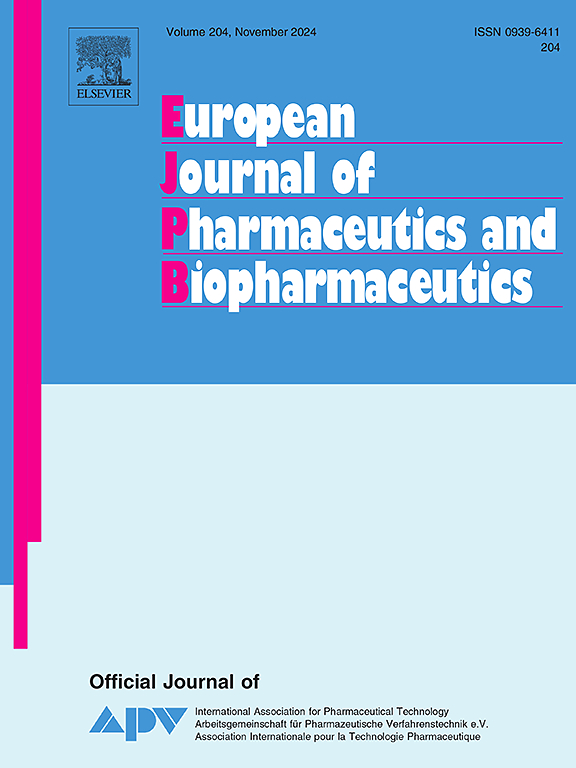Lipid-Polyhydroxyalkanoate Hybrid Nanoparticles as Sustainable Platform for mRNA delivery
IF 4.3
2区 医学
Q1 PHARMACOLOGY & PHARMACY
European Journal of Pharmaceutics and Biopharmaceutics
Pub Date : 2025-05-23
DOI:10.1016/j.ejpb.2025.114755
引用次数: 0
Abstract
The success of mRNA vaccines for the treatment of COVID-19 has generated enormous interest in mRNA therapeutics for various diseases, highlighting the need for robust delivery platforms. Combining the excellent transfection properties of lipids with the high stability of polymeric nanoparticles in a single hybrid system has become an attractive approach to generate next generation mRNA delivery systems. We introduce a modular lipid–polymer hybrid nanoparticle (LPHNP) design based on medium-chain-length polyhydroxyalkanoates (mcl-PHAs) as sustainable alternative to poly(lactic-co-glycolic acid) (PLGA), and a polymer-lipid (DMG-PEG, or poly(2-ethyl-2-oxazoline-myristic acid (PEtOx-MA)). A small library of LPHNPs containing the cationic lipid DOTAP were synthesized using a scalable microfluidic process. Physico-chemical and biological properties of mRNA-LPHNPs were studied. Results showed that the mcl-PHAs (PHAF10 and PHAGlu) derived from Pseudomonas putida can form distinct LPHNPs depending on polymer-to-lipid ratios, and mcl-PHA composition. Cell toxicity, transfection efficiency, serum stability, and the effect of protein interactions was investigated in HeLa cells and human brain endothelial (hCMEC/D3) cells. Importantly, the particles’ biophysical properties and transfection efficacies were not affected after lyophilization and storage at various temperatures for two months. Reporter mRNA was identified across all major organs collected after intravenous injection into mice with limited protein expression in the blood, highlighting the excellent stability of hybrid nanoparticles against blood cell interactions. This approach holds promise for accelerating development of a novel sustainable polymer for mRNA delivery that differs from conventional lipid nanoparticle systems.

脂质-聚羟基烷酸酯复合纳米颗粒作为mRNA的可持续药物传递平台。
mRNA疫苗治疗COVID-19的成功引发了对各种疾病mRNA疗法的巨大兴趣,突出了对强大的递送平台的需求。将脂质优良的转染特性与聚合物纳米颗粒的高稳定性结合在一个单一的杂交系统中,已经成为产生下一代mRNA传递系统的一种有吸引力的方法。我们介绍了一种基于中链长度聚羟基烷酸酯(mcl- pha)的模块化脂质-聚合物杂化纳米颗粒(LPHNP)设计,作为聚乳酸-羟基乙酸(PLGA)和聚脂(DMG-PEG,或聚2-乙基-2-唑啉-肉豆酸(PEtOx-MA))的可持续替代品。采用可扩展的微流控工艺合成了一个含有阳离子脂质DOTAP的小LPHNPs库。研究了mRNA-LPHNPs的理化特性和生物学特性。结果表明,来自恶臭假单胞菌的mcl-PHA (PHAF10和PHAGlu)可以根据聚合物与脂质比和mcl-PHA组成形成不同的LPHNPs。在HeLa细胞和人脑内皮细胞(hCMEC/D3)中研究了细胞毒性、转染效率、血清稳定性和蛋白相互作用的影响。重要的是,在冻干和不同温度下储存两个月后,颗粒的生物物理特性和转染效果没有受到影响。报告mRNA在静脉注射到血液中蛋白表达有限的小鼠后收集的所有主要器官中都被鉴定出来,突出了杂交纳米颗粒对血细胞相互作用的优异稳定性。这种方法有望加速开发一种新的可持续聚合物,用于mRNA传递,不同于传统的脂质纳米颗粒系统。
本文章由计算机程序翻译,如有差异,请以英文原文为准。
求助全文
约1分钟内获得全文
求助全文
来源期刊
CiteScore
8.80
自引率
4.10%
发文量
211
审稿时长
36 days
期刊介绍:
The European Journal of Pharmaceutics and Biopharmaceutics provides a medium for the publication of novel, innovative and hypothesis-driven research from the areas of Pharmaceutics and Biopharmaceutics.
Topics covered include for example:
Design and development of drug delivery systems for pharmaceuticals and biopharmaceuticals (small molecules, proteins, nucleic acids)
Aspects of manufacturing process design
Biomedical aspects of drug product design
Strategies and formulations for controlled drug transport across biological barriers
Physicochemical aspects of drug product development
Novel excipients for drug product design
Drug delivery and controlled release systems for systemic and local applications
Nanomaterials for therapeutic and diagnostic purposes
Advanced therapy medicinal products
Medical devices supporting a distinct pharmacological effect.

 求助内容:
求助内容: 应助结果提醒方式:
应助结果提醒方式:


